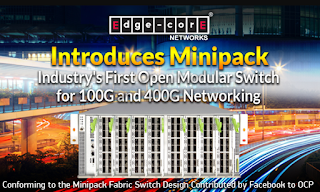Microsoft and Facebook have established a Co-Packaged Optics (CPO) Collaboration with the goal of encouraging common design elements for bridging optics and ASICs.
 The collaboration intends to provide open specifications for design elements, including the electrical signaling interface, optical standard, optical module management interface and reliability requirements. When complete, the open specifications will enable the industry to develop a set of solutions involving switch and ASIC manufacturers, optics suppliers, CMs and others that will create the final package which can then be attached to the switch PCB. The collaboration has targeted the 51T switch generation as the tipping point for industry adoption of co-packaged optics.
The collaboration intends to provide open specifications for design elements, including the electrical signaling interface, optical standard, optical module management interface and reliability requirements. When complete, the open specifications will enable the industry to develop a set of solutions involving switch and ASIC manufacturers, optics suppliers, CMs and others that will create the final package which can then be attached to the switch PCB. The collaboration has targeted the 51T switch generation as the tipping point for industry adoption of co-packaged optics.
"The Co-Packaged Optics Collaboration will provide a customer-driven, system-level view of requirements for co-packaged optics," said Katharine Schmidtke, director, Technology Sourcing, Facebook, responsible for the company's optical technology strategy. "By sharing the specifications, we aim to develop a diverse and innovative supplier ecosystem."
"Providing the industry with a customer-supported set of requirements will create a stable, cooperative environment where suppliers can address one of the optical industry's most important technical challenges," said Jeff Cox, partner director, Network Architecture, Microsoft and executive director of the CPO Collaboration. "As co-founders of the Co-Packaged Optics Collaboration, Microsoft and Facebook invite customers and suppliers to join and collaborate with us."
 The collaboration intends to provide open specifications for design elements, including the electrical signaling interface, optical standard, optical module management interface and reliability requirements. When complete, the open specifications will enable the industry to develop a set of solutions involving switch and ASIC manufacturers, optics suppliers, CMs and others that will create the final package which can then be attached to the switch PCB. The collaboration has targeted the 51T switch generation as the tipping point for industry adoption of co-packaged optics.
The collaboration intends to provide open specifications for design elements, including the electrical signaling interface, optical standard, optical module management interface and reliability requirements. When complete, the open specifications will enable the industry to develop a set of solutions involving switch and ASIC manufacturers, optics suppliers, CMs and others that will create the final package which can then be attached to the switch PCB. The collaboration has targeted the 51T switch generation as the tipping point for industry adoption of co-packaged optics."The Co-Packaged Optics Collaboration will provide a customer-driven, system-level view of requirements for co-packaged optics," said Katharine Schmidtke, director, Technology Sourcing, Facebook, responsible for the company's optical technology strategy. "By sharing the specifications, we aim to develop a diverse and innovative supplier ecosystem."
"Providing the industry with a customer-supported set of requirements will create a stable, cooperative environment where suppliers can address one of the optical industry's most important technical challenges," said Jeff Cox, partner director, Network Architecture, Microsoft and executive director of the CPO Collaboration. "As co-founders of the Co-Packaged Optics Collaboration, Microsoft and Facebook invite customers and suppliers to join and collaborate with us."

















